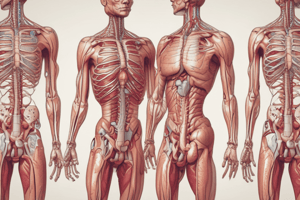Podcast
Questions and Answers
What is the unit of measurement for arterial pressure?
What is the unit of measurement for arterial pressure?
- Centimeters of water
- Pascals
- Millimeters of mercury (mmHg) (correct)
- Atmospheres
What is the purpose of capillary exchange?
What is the purpose of capillary exchange?
- To regulate body temperature
- To increase blood pressure
- To pump blood throughout the body
- To supply oxygen and nutrients to cells and remove waste products (correct)
Which layer of the blood vessel wall comes into contact with the blood?
Which layer of the blood vessel wall comes into contact with the blood?
- Tunica externa
- Intima (correct)
- Media
- Adventitia
What drives the flow of blood back to the heart from the body's tissues?
What drives the flow of blood back to the heart from the body's tissues?
What is the primary function of the media layer in blood vessels?
What is the primary function of the media layer in blood vessels?
What is the term for the force that drives blood flow throughout the circulatory system?
What is the term for the force that drives blood flow throughout the circulatory system?
What is the primary function of valves in the veins?
What is the primary function of valves in the veins?
Where do oxygen and nutrients get exchanged in the circulatory pathway?
Where do oxygen and nutrients get exchanged in the circulatory pathway?
What is the correct sequence of blood vessels in the circulatory pathway?
What is the correct sequence of blood vessels in the circulatory pathway?
What is the term for the series of blood vessels that transport blood throughout the body?
What is the term for the series of blood vessels that transport blood throughout the body?
What is the fate of the blood after it returns to the heart via the veins?
What is the fate of the blood after it returns to the heart via the veins?
Flashcards are hidden until you start studying
Study Notes
Blood Flow
Arterial Pressure
Arterial pressure is the force that drives blood flow throughout the circulatory system. It is measured in millimeters of mercury (mmHg) and is influenced by several factors, including heart rate, blood volume, and blood vessel diameter. In the context of blood flow, pressure is not static but rather fluctuates due to the pumping action of the heart.
Capillary Exchange
Capillary exchange is the process by which substances are transported between the blood and the surrounding tissues. It occurs in the capillary beds, which are the smallest blood vessels in the body. The walls of the capillaries are thin, allowing for a large surface area for exchange. This process is essential for supplying oxygen and nutrients to cells and removing waste products.
Blood Vessel Structure
Blood vessels are composed of three layers: the intima, media, and adventitia. The intima is the innermost layer, which comes into contact with the blood. The media is the middle layer, primarily composed of smooth muscle cells that can contract or relax, thereby regulating blood flow. The adventitia is the outermost layer, which provides structural support and anchors the vessel to surrounding tissues.
Venous Return
Venous return refers to the process by which blood flows back to the heart from the body's tissues. This flow is driven by the pressure gradient between the heart and the peripheral tissues. Valves in the veins prevent the backflow of blood, ensuring that blood is always moving towards the heart.
Circulatory Pathway
The circulatory pathway is the series of blood vessels that transport blood throughout the body. It begins with the heart, which pumps blood into the aorta. The aorta then branches into smaller arteries, which further divide into arterioles and capillaries. Oxygen and nutrients are exchanged in the capillaries, and the blood then returns to the heart via the veins. The blood is then pumped back into the aorta to begin the cycle again.
Conclusion
Understanding the principles of blood flow is crucial in various fields, including medicine, physiology, and engineering. This knowledge can help in the diagnosis and treatment of diseases, the development of medical devices, and the study of organ function. By understanding the factors that influence blood flow, we can gain a better appreciation of the complex interplay between the heart, blood vessels, and tissues.
Studying That Suits You
Use AI to generate personalized quizzes and flashcards to suit your learning preferences.




